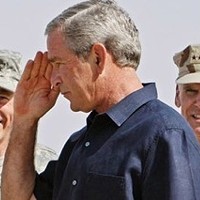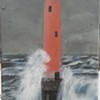The bomb in our back yard
Averting armageddon declared 'impracticable'
In the weeks after Sept. 11, countries like France and Hungary began making plans to protect their major nuclear facilities.
France installed radar systems to scout out low-flying planes and surface-to-air missiles to shoot them down. Hungary did the same. Meanwhile, in the United States, something very different was going on.
An obscure, 119-page report disappeared from the reading room at the Nuclear Regulatory Commission in the weeks after the 2001 terrorist attacks. It was a study that showed that many of the large commercial aircraft flown today could crash through the protective containment buildings that house nuclear reactors if the planes flew fast enough and carried enough fuel.
For 20 years, the NRC, the federal agency that regulates the nation's 103 nuclear plants, had been well aware that the infrastructure of the nation's nuke plants wasn't built to withstand the impact of a plane crash. But before Sept. 11, no one spent much time worrying about that because the likelihood that a plane would happen to crash into a reactor seemed remote.
As late as 2002, when I first wrote about this topic, you could still find the press release on the NRC's Web site saying that nuclear reactors are among the most hardened structures in the country, designed to withstand extreme events like hurricanes and earthquakes.
"However," the statement continued, "the NRC did not specifically contemplate attacks by aircrafts, such as Boeing 757s and 767s, and nuclear power plants were not designed to withstand such crashes."
Today, the NRC's press releases about nuclear plant penetrability read very differently.
Since Sept. 11, the NRC and the nuclear industry have spent millions on additional studies that concluded there was nothing to worry about because the country's reactors were strong enough to withstand a direct hit from a large, fuel-laden plane. Well, that's what the NRC claimed the new studies said. Unlike the report that disappeared from the NRC's reading room, the results of the new studies were classified.
After the terror attacks in 2001, Westchester County Journal News reporter Roger Witherspoon and several others wrote furious pieces about the vanished NRC report and the vulnerability of our nuke plants.
But today, the national media covers the debate about the vulnerability of our nuclear reactors and spent fuel pools like a tennis match between the nuclear industry and anti-nuclear activist groups, in which the true vulnerability of our plants to aerial attack is unknowable because it is classified. That's hogwash.
A 1982 study conducted at Argonne National Laboratory in Illinois for the U.S. Department of Energy and the NRC -- the one that disappeared from the NRC reading room -- found that if a large jet crashed into the concrete containment dome of a nuclear reactor at 466 miles per hour or greater, the explosion of fuel and fuel vapor from the plane could overwhelm shields inside the dome that protect the reactor. At 153 feet long and 336,000 pounds, the Boeing 707-320 used in the Argonne study was considered a large commercial jet at the time. By comparison, today's Boeing 767-300, the same aircraft that crashed into the World Trade Center towers, is 180 feet long and weighs 412,000 pounds.
Unlike the NRC, Duke Energy officials were frank about the structural strength of the nuclear reactors at McGuire Nuclear Station when Creative Loafing asked about it in 2002.
"We have definitively said they were not designed to withstand the impact of commercial aircraft," Tim Pettit, manager of nuclear public affairs at Duke, told CL at the time.
Now the NRC is building its entire "security plan" -- they actually called it that -- around the fiction of robust nuclear plants that "provide adequate protection" from an airplane attack. Last week, the commission voted 5-0 for a plan that declared making nuclear plants resistant to airliner attack was "impracticable."
According to this "plan," there is no need for firm no-fly zones around the reactors, radar, anti-aircraft weapons to shoot down incoming planes or the reinforced barriers some had proposed that would slow down an incoming plane and sheer off its wings, where a lot of the jet fuel is stored, before a crash.
The nuclear industry has long considered these protective measures too expensive, but there's something else at stake. Industry leaders now have a chance to get new nuclear plants -- clean energy sources this nation desperately needs -- approved and built for the first time in decades. But the approval process is grueling and doubts about nuclear plant safety could grind it to a halt and cost the industry the billions it invested in design and planning.
So the fiction of terror-proof, impenetrable nuclear pools and reactors is being maintained. According to the plan the NRC approved, it will now be the sole responsibility of the military, the Federal Aviation Administration and the Transportation Security Administration -- whose airport screeners regularly miss knives and other weapons -- to stop aerial attacks.
If that fails, the industry would rely on plant operators' abilities to manage explosions or fires, radiation protection measures and federal evacuation plans, which don't account for nuclear terrorist attacks.
A bumper sticker I saw recently sums this situation up nicely. It had a picture of President Bush and three letters: WTF?
If you love (or love to hate) CL columnist Tara Servatius in print, then be sure to check her out every week on the radio as the host The Citizen Servatius Show.
The show, which airs every Sunday from 11 a.m. to 2 p.m. on WBT (1110 AM), features our controversial and award-winning writer discussing local and national news and issues.
Speaking of 4.75000
-

MIA
Nov 21, 2007 -

Something Old, Something New
Oct 10, 2007 -

Juvenile-in-Chief 'Kicks Ass'
Sep 12, 2007 - More »
Latest in Citizen Servatius
Calendar
-

Wine & Paint @ Blackfinn Ameripub- Ballantyne
-

Queen Charlotte Fair @ Route 29 Pavilion
-

NEW WINDOW GALLERY-Pat Rhea-ACRYLIC PAINTINGS-April 05-30 2024 VALDESE, NC 28690 @ New Window Gallery/Play It Again Records
- Through April 30, 12 p.m.
-

TheDiscountCodes
-

Face to Face Foundation Gala @ The Revelry North End
-
Esports in Charlotte Takes Off: A Guide to Virtual Competitions and Betting
-
Homer's night on the town 41
If you drank a shot with the Knights mascot on Sept. 20, you were basically harboring a fugitive
-
Beauty Industry Trends To Look Out For In Charlotte In 2022






